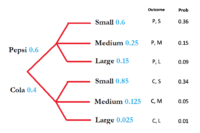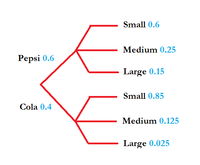You are using an out of date browser. It may not display this or other websites correctly.
You should upgrade or use an alternative browser.
You should upgrade or use an alternative browser.
Tree Diagram
- Thread starter nasi112
- Start date
pka
Elite Member
- Joined
- Jan 29, 2005
- Messages
- 11,978
What is \(\mathscr{P}(M)=\mathscr{P}(M\cap P)+\mathscr{P}(M\cap C)=~?\)View attachment 26350If we have the tree diagram above and we want to find [MATH]P(Medium)[/MATH]
Thanks Jomo for showing up. In this case, the probability will be 2 which makes no sense.I have a better question. What is the probability that someone chooses a small, medium or large drink. Would it be .6+.25+.15+.85+.125+.025?
Thanks pka for showing up. This meansWhat is \(\mathscr{P}(M)=\mathscr{P}(M\cap P)+\mathscr{P}(M\cap C)=~?\)
[MATH]P(medium) = (0.6)(0.25) + (0.4)(0.125) = 0.2[/MATH]
If this is the correct answer, then in which cases I should sum the probabilities in the 2nd group.
By groups, I mean Pepsi and Cola are first group, and S, M, L are second group.
I always put in the outcomes and their probabilities, so that I'm now ready to face any question.

E.g. your question P(Medium). Just go through the outcomes and add the ones which contain M(edium):
0.15 + 0.05
You could I suppose answer a conditional probability question: e.g. given that it is a Pepsi, what is the probability it is Small or Medium,
by just adding 0.6 and 0.25.
But conditional probabilities can be done using my two columns too, so it's not necessary to do it that way.

E.g. your question P(Medium). Just go through the outcomes and add the ones which contain M(edium):
0.15 + 0.05
You could I suppose answer a conditional probability question: e.g. given that it is a Pepsi, what is the probability it is Small or Medium,
by just adding 0.6 and 0.25.
But conditional probabilities can be done using my two columns too, so it's not necessary to do it that way.

